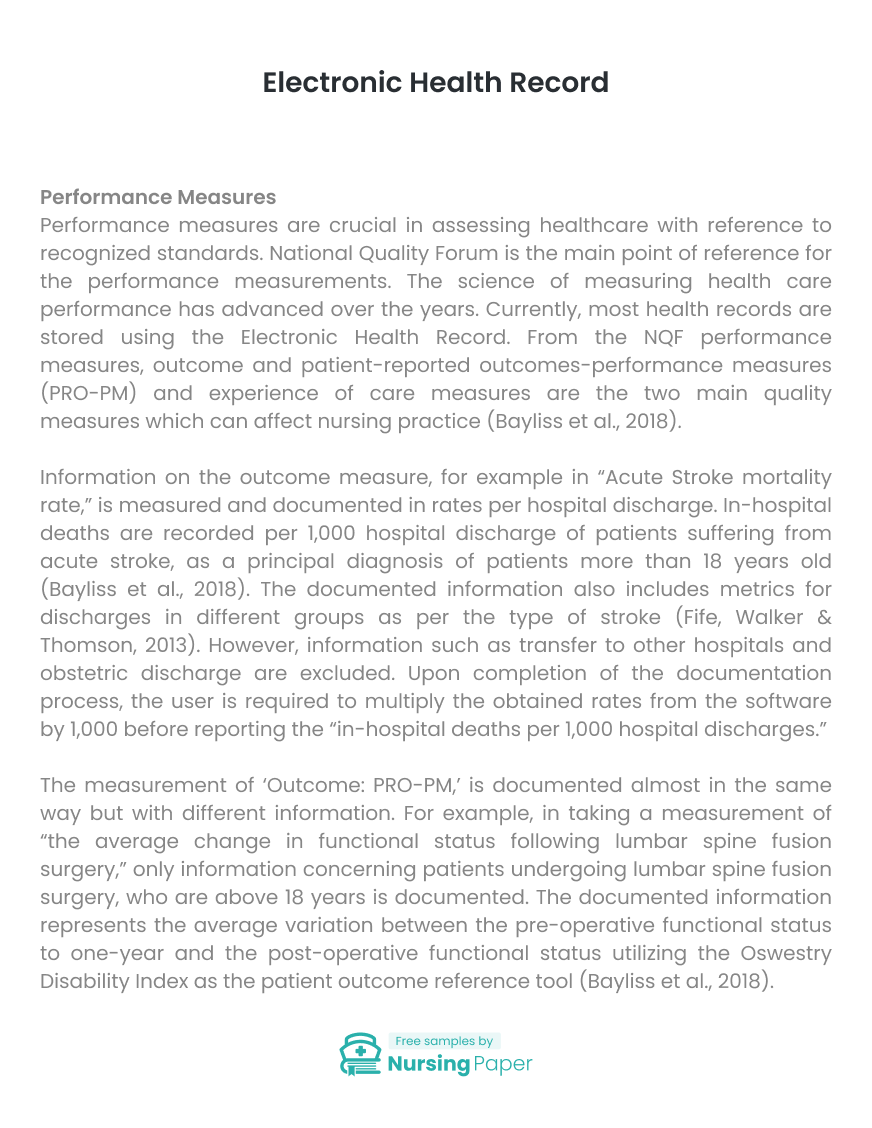
Electronic Health Record
Performance Measures
Performance measures are crucial in assessing healthcare with reference to recognized standards. National Quality Forum is the main point of reference for the performance measurements. The science of measuring health care performance has advanced over the years. Currently, most health records are stored using the Electronic Health Record. From the NQF performance measures, outcome and patient-reported outcomes-performance measures (PRO-PM) and experience of care measures are the two main quality measures which can affect nursing practice (Bayliss et al., 2018).
Information on the outcome measure, for example in “Acute Stroke mortality rate,” is measured and documented in rates per hospital discharge. In-hospital deaths are recorded per 1,000 hospital discharge of patients suffering from acute stroke, as a principal diagnosis of patients more than 18 years old (Bayliss et al., 2018). The documented information also includes metrics for discharges in different groups as per the type of stroke (Fife, Walker & Thomson, 2013). However, information such as transfer to other hospitals and obstetric discharge are excluded. Upon completion of the documentation process, the user is required to multiply the obtained rates from the software by 1,000 before reporting the “in-hospital deaths per 1,000 hospital discharges.”


The measurement of ‘Outcome: PRO-PM,’ is documented almost in the same way but with different information. For example, in taking a measurement of “the average change in functional status following lumbar spine fusion surgery,” only information concerning patients undergoing lumbar spine fusion surgery, who are above 18 years is documented. The documented information represents the average variation between the pre-operative functional status to one-year and the post-operative functional status utilizing the Oswestry Disability Index as the patient outcome reference tool (Bayliss et al., 2018). However, information for patients going through spine related cancer, infection and congenital or idiopathic scoliosis and fracture are excluded.
The above pieces of information are compiled and documented in an Electronic Health Record software (Fife, Walker & Thomson, 2013). Most of the these documented medical records are collected by the nurse taking care of a particular patient. It is advisable that the records for an individual patient are taken by a specified nurse to avoid errors. It also makes it easier to update the patient details concerning the therapeutic outcome of the treatment prescribed. These records are then processed and stored for future retrieval. The documented data is essential for both the patient and the caregiver. When required, the information is collected and reported in several ways, both manually and electronically, for example, claims, charts abstraction, assessment instrument, and registry.
The submission of quality measure data, stored and retrieved from Electronic Health Records is still under test by the Centers for Medicare & Medicaid Services (CMS) (Fife, Walker & Thomson, 2013). Once proven effective, most hospitals will embrace the use of more advanced technology (EHR) for hospital record keeping. EHR will ease the access to standard information required to support direct health care, clinical decision support, public health reporting and Medical research.

1. Fife, C. E., Walker, D., & Thomson, B. (January 01, 2013). Electronic Health Records, Registries, and Quality Measures: What? Why? How? Advances in Wound Care, 2, 10, 598-604.
2. Bayliss, E. A., Tabano, H. A., Gill, T. M., Anzuoni, K., Tai-Seale, M., Allore, H. G., Ganz, D. A., … Mazor, K. M. (May 10, 2018). Data Management for Applications of Patient Reported Outcomes. Egems (generating Evidence & Methods to Improve Patient Outcomes), 6, 1.)



The download will start shortly.

The download will start shortly.
 Subject:
Medicine
Subject:
Medicine  Number of pages: 7
Number of pages: 7  Subject:
Medicine
Subject:
Medicine  Number of pages: 12
Number of pages: 12  Subject:
Medicine
Subject:
Medicine  Number of pages: 4
Number of pages: 4  Subject:
Nursing
Subject:
Nursing  Number of pages: 5
Number of pages: 5  Subject:
Health and Social Care
Subject:
Health and Social Care  Number of pages: 2
Number of pages: 2  Subject:
Nursing
Subject:
Nursing  Number of pages: 3
Number of pages: 3  Subject:
Health and Social Care
Subject:
Health and Social Care  Number of pages: 2
Number of pages: 2  Subject:
Medicine
Subject:
Medicine  Number of pages: 5
Number of pages: 5  Subject:
Health and Social Care
Subject:
Health and Social Care  Number of pages: 2
Number of pages: 2  Subject:
Medicine
Subject:
Medicine  Number of pages: 2
Number of pages: 2  Subject:
Nursing
Subject:
Nursing  Number of pages: 3
Number of pages: 3  Subject:
Medicine
Subject:
Medicine  Number of pages: 5
Number of pages: 5  Subject:
Health and Social Care
Subject:
Health and Social Care  Number of pages: 3
Number of pages: 3  Subject:
Nursing
Subject:
Nursing  Number of pages: 4
Number of pages: 4  Subject:
Health and Social Care
Subject:
Health and Social Care  Number of pages: 9
Number of pages: 9 
